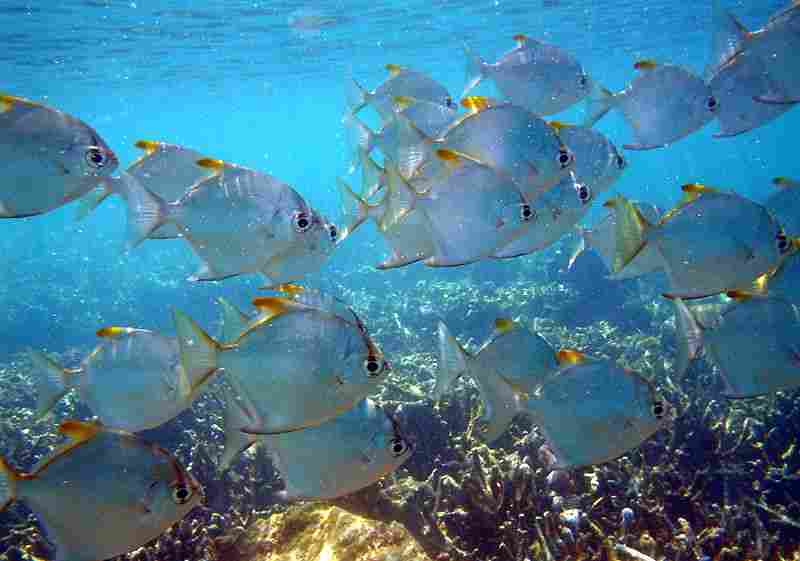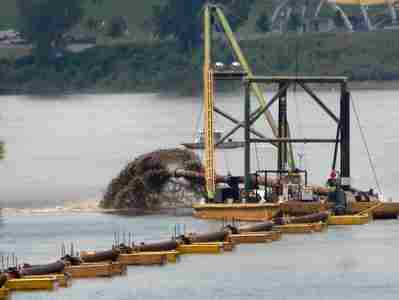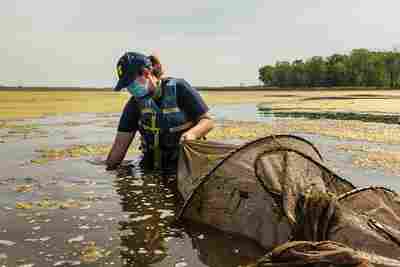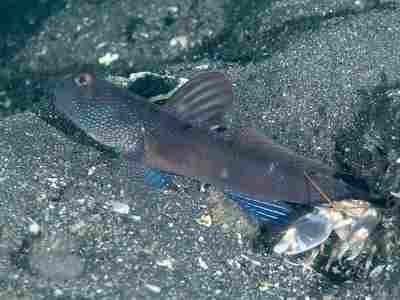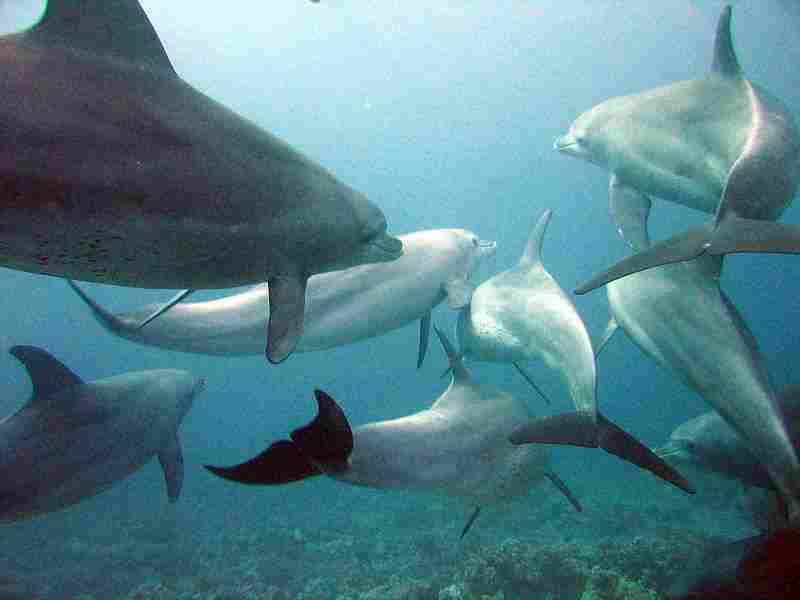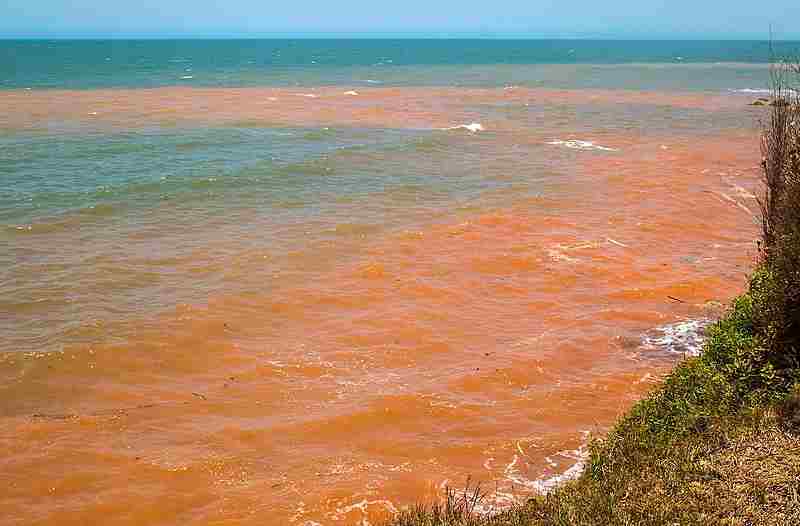9 Estuary Abiotic Factors and Their Characteristics
Estuary abiotic factors are; light, water, dissolved gases, nutrients, sediments, parent rock materials, physicochemical conditions, flow characteristics, and water depth.
This article discusses estuary abiotic factors and their characteristics, as follows;
1). Light (as one of the Estuary Abiotic Factors)
Light is an important abiotic factor that plays a key role in the establishment and sustenance of estuarine ecosystems.
It shares links with estuarine biotic factors, by influencing various biological processes and trophic interactions within these transitional environments, where freshwater meets and intrudes marine water bodies [2].
Light availability affects multiple phenomena in estuaries, including species distribution, primary production, nutrient cycling, and overall ecosystem sustainability.
Functions of Light in Estuarine Ecosystems
The function of light as an abiotic factor in estuaries, include facilitation of photosynthesis, species distribution, trophic relationships, habitat structuring, and nutrient recycling.
Light (from solar radiation) is the primary energy resource for photosynthesis; the process through which autotrophic organisms (such as phytoplankton and seagrasses) transform light energy and inorganic raw materials, into organic biomass [14]. Such autotrophic organisms form the base of the food web and provide bioenergy to other organisms in the ecosystem.
Photosynthetic organisms in estuaries, release oxygen as a byproduct of photosynthesis; implying that they are instrumental to the estuarine oxygen cycle. Oxygen is itself vital for the respiration of aquatic organisms, ensuring their survival and promoting the resilience/growth of the ecosystem.
Light availability influences the spatial distribution of organisms in the water column, especially across a vertical profile.
Different species have different levels of light tolerance/requirement, and adaptations that enable them thrive at certain depths. Light penetration affects the distribution of phytoplankton, which in turn impacts the distribution of all aquatic animals that depend directly or indirectly on them.
Trophic relationships in estuaries are affected by the amount of light reaching the water surface, which determines the growth and performance of primary producers. Producer-performance determines the availability of food for herbivores, and subsequently for carnivorous and omnivorous organisms in higher trophic levels.
Submerged aquatic vegetation, such as macroalgae and seagrasses, depend on light for growth. These autotrophs form meadow-habitats that provide shelter and nursery areas for several aquatic organisms. Light availability influences the areal extent, and health of these habitats.

Nutrient cycling is linked to the productivity of primary producers, which is in turn driven by light availability in estuarine ecosystems. The nutrients taken-up by primary producers are recycled through the food chain, and contribute to the resource-supply dynamics of the estuary.
Importance of Abiotic Factors in Estuaries: An Overview
In estuaries, multiple abiotic factors interact continuously to create a complex and dynamic environment. While all abiotic factors in an estuary are important, some of the most critical ones include; salinity, temperature, water flow, turbidity, nutrient availability, light, and oxygen concentration.
Estuaries experience fluctuating levels of salinity due to the mixing of freshwater and saltwater masses [4]. This influences the types of species that are able to thrive in different salinity conditions, and affects their distribution.
Temperature variations influence the growth, reproduction, and general metabolic rates of organisms. Some species are adapted to narrow ranges of temperature, while others can tolerate a relatively-broad temperature range.
Water flow and turbidity affect nutrient transport, light penetration and sediment deposition. These factors affect primary production, species interactions, and habitat availability.
Nutrient availability and concentration, influence primary production and the overall productivity of the ecosystem. Nutrient levels in estuaries are affected by factors like freshwater input, sediment load, and human activities (where agriculture can facilitate excessive nutrient influx and pollution [11]).
Oxygen concentration is an essential abiotic factor that determines the survival of aquatic organisms. Oxygen availability changes under the influence of factors like temperature, salinity, and nutrient levels.
2). Water
Water is the fundamental medium that establishes and sustains estuarine ecosystems.
Its properties and internal dynamics, have profound influence on the conditions, distribution, behavior, and interactions of other abiotic factors as well as living organisms, within the transitional estuary environment.
Functions of Water in Estuarine Ecosystems
The functions of water in estuaries include; physical support, habitat formation, transport medium, nutrient and particle mobilization, temperature regulation, salinity control, oxygen dissolution, and physicochemical interactions.
Water provides buoyancy and support for aquatic organisms in estuaries, allowing them to move, feed, and reproduce within the ecosystem.
Another function that can be attributed to water in estuaries is habitat creation.
The water column and bottom substrate, create diverse habitats for estuarine organisms. Different depths and sediment types represent niches for different species.
Water currents and tides transport sediments, nutrients, and living organisms throughout the ecosystem. This movement facilitates nutrient cycling, microhabitat-colonization, and connectivity among different areas of the estuary.
Nutrients and particles are transported as a result of water movement from one area to another. This influences primary production and nutrient cycling. Water transports suspended particles that can provide food for filter-feeding organisms.
Temperature regulation can be attributed to water in an estuary, which acts as a heat sink, and controls temperature fluctuations in the ecosystem. It moderates temperature extremes, which improves the survival of aquatic organisms.
Water in estuaries are subject to changes in salinity, due to the mixing of freshwater and saltwater. This variation creates diverse salinity zones that support different species adapted to specific salinity ranges.
Oxygen, which is vital for the survival of aquatic organisms, dissolves in water. Water movement and mixing facilitate gas exchange in estuaries, maintaining adequate oxygen levels for respiration.
Lastly, water serves as a medium for diverse physical and chemical processes, such as nutrient diffusion, sediment transport, and chemical reactions.
Abiotic Factors Influencing Organisms in Estuaries (Differs from "Most Critical" Abiotic Factors Discussed In Section 1)
Abiotic factors influencing organisms in estuaries are; salinity, temperature, water flow, turbidity, nutrient availability, oxygen concentration, pH, tides, water currents, and substrate.
Fluctuations in salinity influence the distribution and survival of estuarine species, which are usually adapted to specific salt concentrations.
Temperature affects metabolic rates, reproduction, growth, and behavioral patterns of aquatic organisms.
Turbidity influences light penetration, nutrient transport, sediment deposition, and feeding behaviors.
Nutrient concentrations influence primary production and nutrient cycling in the ecosystem, affecting overall productivity.
Oxygen Concentration influences the distribution and rate of survival, of aquatic organisms (depending on the oxygen demands of species affected).
pH levels affect other abiotic element like nutrient availability and reactivity, and can drive modifications in the physiology of aquatic organisms [5].
The compositional and textural characteristics of the sedimentary substrate in estuaries, influence habitat availability and organic settlement.
3). Dissolved Gases (as one of the Estuary Abiotic Factors)
Dissolved gases, particularly oxygen (O2), play a key role in the introduction and sustenance of life in estuarine ecosystems. The concentration of dissolved gases affects various physical, biological and chemical processes, and impacts the occurrence of aquatic organisms.
Functions of Dissolved Gases in Estuarine Ecosystems
Functions of dissolved gases in estuarine ecosystems include; respiration, aerobic decomposition, redox reaction, and carbon cycling.
Aquatic organisms, including microorganisms and large mammals, require oxygen for respiration. The availability of dissolved oxygen (DO) determines their growth, metabolic rates, and survival [3].
Some aquatic decomposer organisms, break down organic matter through aerobic decomposition, a process that relies on oxygen. Adequate DO levels support efficient biodegradation, by which nutrients are recycled within the ecosystem.
As stated earlier, fish and other aquatic organisms depend on dissolved oxygen for survival. Oxygen-rich estuarine waters, support fish populations and also provide suitable conditions for other species like crustaceans and mollusks.

The amount of oxygen that can dissolve in water is dependent on factors like salinity, temperature, and atmospheric pressure. Levels of oxygen saturation affect the overall wellbeing of the ecosystem.
Redox reactions in estuaries are influenced by oxygen and other dissolved gases, which influence how substances gain or lose electrons. These reactions affect the availability and transformation of nutrients and other essential chemicals in the water.
Nutrient cycling is directly affected by oxygen availability, which affects the supply of phosphorus and nitrogen. Oxygenated conditions promote denitrification and nitrification and processes, affecting nutrient availability for producers and consumers.
Lastly, dissolved gases can affect the carbon cycle in estuarine ecosystems, by influencing the balance between carbon dioxide (CO2) absorption and production by aquatic plants and microbes.
Abiotic Factors Influencing Dissolved Oxygen
Abiotic factors influence of dissolved oxygen concentration in estuarine waters include; temperature, salinity, turbidity, atmospheric pressure, and water flow.
Warmer water holds less oxygen in solution [7]. This means that as estuarine-water temperature rises, its dissolved oxygen concentration decreases.
Higher salinity levels are associated with lower solubility of oxygen. Estuarine mixing of freshwater and seawater can lead to continuous variations in oxygen concentrations.
Turbid water with suspended particles can limit the degree of light penetration. Reduced light levels negatively impact photosynthesis by aquatic autotrophs, potentially affecting oxygen production.
Atmospheric pressure affects the equilibrium between gases in the atmosphere, and those dissolved in water bodies. Lower atmospheric pressure at higher altitudes can affect oxygen solubility.
Lastly, various forms of water movement in estuaries, such as tides, currents, and mass-mixing affect the distribution of dissolved oxygen by moving water, and facilitate gas exchange at the water's surface.
4). Nutrients
Nutrients are a fundamental abiotic factor, that affects the functioning of estuarine ecosystems.
Estuaries, where freshwater from rivers meets saltwater from the ocean, are highly productive zones due to the influx of nutrients brought in by the flowing water masses. These nutrients are essential for the growth and survival of aquatic producers and consumers, and contribute to the overall diversity and health of the ecosystem.
Functions of Nutrients in Estuarine Ecosystems
Functions of nutrients in estuarine ecosystems include; primary production, food web support, biomass accumulation, water quality control, and habitat formation.
Nutrients like phosphorus and nitrogen, are important for the process of photosynthesis in estuarine plants and phytoplankton [10]. These primary producers must utilize nutrients, along with sunlight, to produce organic matter and oxygen.
Food webs are supported and driven by nutrients, which can be said to form the base of this ecological structure. Phytoplankton, which are primary producers, are the primary food source for several organisms, including zooplankton, which in turn are consumed by other organisms in higher trophic levels such as predatory fish and birds. All processes that make up the food web begin with (or at least involve) the utilization of nutrients.
Ecosystem productivity can be traced to the growth of autotrophs in estuaries, which in turn is dependent on nutrient availability.
Higher nutrient concentrations can be associated with increased growth and higher biomass production rates, contributing to overall ecosystem productivity.
Biomass accumulation is a product of the uptake of nutrients, by phytoplankton and aquatic macrophytes in estuaries. This accumulated biomass becomes sustains grazers and filter feeders.
Nutrient concentrations directly affect water quality in estuaries. Excessive amounts of nutrients can lead to eutrophication, causing algal blooms, oxygen depletion, and disruption of the stability of the ecosystem.
Cycling of nutrients within estuarine ecosystems is an essential phenomenon that determines the continuity of life forms. Decomposition of organic matter by bacteria and detritivorous decomposers, releases nutrients back into the water, so that they become available for reuse by other organisms.
The formation of habitats is also linked to nutrient dynamics in estuaries. Nutrient-rich sediments support the growth of submerged aquatic vegetation (SAV), including seagrasses and salt marsh grasses. Biomass from these autotrophs may provide shelter, breeding grounds, and food for various species.
Sources of Nutrients in Estuaries
Sources of nutrients in estuaries include;
1. Freshwater runoff
2. Urban stormwater
3. Agricultural waste
4. Atmospheric deposition
5. Tidal exchange
The primary source of nutrients in estuaries is arguably freshwater runoff from adjacent rivers. Rivers transport nutrients from the surrounding watershed, which may include agricultural lands, urban areas, and natural landscapes.
Nutrients can enter the estuary from various sources within the watershed area, including agricultural runoff carrying fertilizers, urban stormwater runoff containing anthropogenic contaminants, and natural erosion from soils and parent rocks.
Atmospheric deposition of nutrients in estuaries is facilitated by factors like rainfall and atmospheric (mineral-rich) dust particles.
Ocean water that is enriched with nutrients, can enter into estuaries during tidal exchange, thereby supplementing the nutrient pool within the estuarine ecosystem.
5). Sediments (as one of the Estuary Abiotic Factors)
Sediments are important estuary abiotic factors, and occupy diverse roles in the functioning and sustenance of these habitats.
Estuarine sediments are composed of various particles, including sand, silt and clay [9]. They also contain organic matter, which accumulates on the bottom of the estuary due to the interaction of sediment transport, biological activity and water flow.
Functions of Sediments in Estuarine Ecosystems
Functions of sediments in estuarine ecosystems include; habitat and shelter creation, nutrient storage and cycling, water purification, oxygen exchange, element cycling, macrophyte support, erosion and deposition.
Habitat and shelter are provided by sediments, for various estuarine organisms. Benthic organisms such as crustaceans, mollusks and worms, live within burrows in sediments, or on the surface of the sedimentary substrate, utilizing these sediments for nesting and protection from predators.
Nutrients are stored and cycled with the help of sediments. These include nitrogen, phosphorus, and carbon.
Organic remains and detritus settle in estuarine sediments, where they are broken down by decomposers. The released nutrients contribute to the estuarine food web, and support the process of primary production.
Water filtration and purification can be attributed to sediments in estuaries. This is because sediments act as natural filters that trap and retain suspended particles and other pollutant materials carried by water. This function helps improve water quality by reducing turbidity and removing contaminants.
Exchange of oxygen and other gases occurs between sediments and the overlying water in estuaries. In well-aerated sediments, oxygen is taken up by aerobic organisms, and used to drive essential processes like aerobic degradation of organic matter [1]. In anoxic sediments, other redox reactions may occur.
Sediments are important sites of biogeochemical processes, which include active oxidation-reduction reactions. Elements like iron, manganese and nitrogen, undergo transformations within the sediments, influencing the circulation of resources and sustenance of the ecosystem. Climate-related processes like carbon sequestration also occur in estuarine soils.
Estuarine sediments provide mechanical and nutritional support for macrophytes. Submerged aquatic vegetation, or macrophytes, can anchor in sediments to withstand the mechanical pull of water currents and tides. These plants contribute to habitat diversity, help stabilize the sediments, and provide cover for small heterotrophic organisms.
Estuarine geomorphology is shaped by sediments, through the dynamics of their accumulation in certain areas and displacement from others. Changes in sedimentation influence the distribution of habitats and sediment-dependent organisms (like benthic burrowers).
Status of Sediment as An Abiotic Factor
Sediment is an abiotic factor in an ecosystem, because it comprises of inorganic and non-living components that have physicochemical and biological implications for the environment.
Sediments consist primarily of mineral particles, which may combine with detrital organic matter, to occupy a key position in the abiotic environment of estuaries.
Abiotic Factors of a Shallow Estuary and Their Causes
Abiotic factors in a shallow estuary and their causes include; fluctuating salinity from tidal mixing, turbidity from suspended sediments, and high temperature from shallow water depth/low volume.
Fluctuations in salinity occur in estuaries as a result of the mixing of fresh river water and salty ocean water. Evaporation can also lead to noticeable changes in salinity levels, within a shallow estuary.
Turbidity in shallow estuaries is often high because of the presence of suspended sediments that are unable to settle within the narrow vertical profile of the water column.
These suspended sediments can make the water in a shallow estuary less clear. In such scenarios, turbidity can be attributed to erosion, runoff, and sediment resuspension due to current and wave action.
Shallow water depth and relatively-low volume in estuaries, can result in higher water temperatures. Shallow waters absorb and retain heat more effectively (due to their low relative volume and lower rates of water-mass mixing), leading to elevated temperatures.
6). Parent Rock Materials
Parent rock materials, also called bedrock or substrate, are closely related to the sediments found in estuarine ecosystems.
These materials serve as the source of mineral particles that eventually contribute the bulk of estuarine sediments.
The interaction between parent rock materials, erosion processes, sediment transport, and sediment deposition; influences the physical and chemical conditions (as well as characteristics) of the sedimentary environment in an estuary.
Relevance of Parent Rock Materials in An Estuary
Parent rock materials are important in an estuary for their contributions to (and influence upon) mineral composition, particle size, nutrient content, physical structure, and pH of sediments and water in the ecosystem.
Mineral composition of the sediments in estuaries is determined by parent rock materials. Different types of bedrock contain various minerals that contribute unique chemical elements and physical properties, to the resulting sediments.
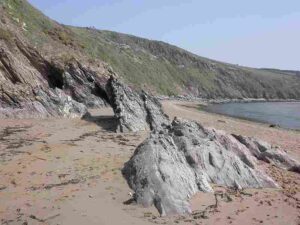
As implied above, the particle size(s) of estuarine sediments is influenced by the parent rock materials. Rocks with varying mineralogical compositions, levels of hardness and erosion-resistance can produce fine or coarse sedimentary particles.
Parent rock materials contain varying amounts of nutrients [6]. As these materials weather and erode, they release their nutrients, which are carried by water to estuarine environments, and influence nutrient availability in both bottom substrate and water column.
Petrophysical structure and textural properties of the parent rock materials, such as their porosity and permeability, can affect the conditions of water movement within sediments and influence nutrient exchange.
Lastly, the natural pH of the parent rock materials can influence the pH of the surrounding water and sediments, affecting the availability of nutrients and influencing the types of organisms that thrive in the estuary.
Link Between Parent Rock Materials and Sediments in the Estuary Ecosystem
The link between parent rock materials and estuarine sediments is based on factors like erosion and weathering, sediment transport, deposition, benthic habitat, nutrient cycling, and physical characteristics.
Parent rock materials are continuously acted upon by agents of erosion and weathering, which break them down into smaller particles. These particles are displaced by water from rivers and streams into estuaries, where they contribute to sediment loads.
The eroded particles from parent rock materials are transported by currents and tides within the estuary. They may settle and accumulate in different areas on the basis of their size and density.
Sediments, composed of particles derived from parent rock materials, are deposited on the estuary floor. This deposition creates different types of substrate, such as sandy, silty, and clayey layers.
The composition and texture of sediments are determined by their parent rock sources; and influence benthic habitats, determining the types of organisms that can thrive in different zones of the estuary.
Nutrients released from parent rock materials, are precursors to nutrient cycling in estuarine sediments. These nutrients can influence primary production and the entire estuarine food web.
Physical characteristics of parent rock translate into the physical properties of estuarine sediments, that affect water movement, oxygen exchange, and sediment stability.
7). Physicochemical Conditions (as one of the Estuary Abiotic Factors)
Physicochemical conditions in an estuary are determined by various physical and chemical parameters of the water and sediments. These parameters influence the overall state of the ecosystem.
Physicochemical conditions are dynamic and can vary widely under the influence of factors like tides, freshwater inflow, temperature fluctuations, and human activities. They directly affect the biological communities, nutrient cycling, and overall ecological balance within the estuarine environment.
Functions of Physicochemical Conditions in Estuaries
Functions of physicochemical conditions in estuaries include determination of organic diversity and performance, control of sedimentation and habitat formation, as well as primary production and adaptation.
Salinity is an important factor in estuaries, that is highly dynamic due to the mixing of freshwater and saltwater masses. It determines the types of organisms that can inhabit different parts of the estuary and influences their adaptive physiologies and behaviors.
pH levels have a key function in the chemical reactions that occur in estuarine water and sediments. Drastic changes in pH can cause significant stress or harm to aquatic organisms. On the other hand, optimal pH levels are important for the survival of various species.
Dissolved oxygen is vital for aquatic organisms to perform respiration. It directly determines the survival of fish, mollusks, crustaceans, and other estuarine life forms. Low oxygen levels, often caused by pollution and organic matter decomposition, can lead to hypoxic or anoxic conditions.
Temperature influences metabolic rates, growth rates, and diverse physiological functions of aquatic organisms. Seasonal temperature variations, and thermal stratification, are involved in shaping the distribution of species within the estuary.
Chlorophyll is a proxy for measuring phytoplankton biomass (and biological productivity), which is foundational to the estuarine food web. Monitoring chlorophyll levels provides insights into the overall productivity and health of estuaries.
Physicochemical conditions are related to the availability of nutrients such as nitrogen, potassium and phosphorus, which are essential for primary production and the growth of hydrophytes and algae.
Sediment characteristics are also impacted by physicochemical conditions. These characteristics include porosity, composition, and nutrient content, which in turn influence benthic habitat distribution, and nutrient cycling.
Physicochemical conditions can influence the toxicity of estuarine environments. For example, low dissolved oxygen, low salinity and high pH can facilitate the release of toxic compounds from sediments [12].
Factors like suspended sediments can increase turbidity and affect water clarity. Clear water is essential for light penetration, which is a prerequisite for photosynthesis by estuarine producers.
Physicochemical Parameters of the Estuary
Some common physicochemical parameters measured in an estuary include;
1. Salinity
2. pH
3. Dissolved oxygen
4. Temperature
5. Turbidity
6. Nutrient concentrations (nitrogen, phosphorus)
7. Total suspended solids
Importance of Monitoring Physicochemical Conditions
Regular monitoring of physicochemical conditions is important for assessing the health of a ecosystems like estuaries. Changes in these conditions can indicate environmental impacts of industrial pollution, eutrophication, habitat degradation, and climate change among others.
Effective management and conservation strategies for estuaries can only be developed based on an understanding of the intricate relationships between physicochemical factors and the biological community.
8). Flow Characteristics
Flow characteristics, including velocity, flow trend (turbulence, laminar flow), and tidal influences; are all important abiotic factors in the estuarine ecosystem.
These flow dynamics influence nutrient distribution, sediment transport, oxygen levels, habitat availability, and organic survival, thereby determining ecosystem sustainability as a whole.
Functions of Flow Characteristics in Estuaries
In estuaries, flow characteristics are linked to tidal mixing, nutrient transport, sediment dynamics, oxygen levels, habitat variation, transport of organic matter, spatiotemporal connectivity, salinity distribution, and thermoregulation.
Tidal flows are a significant driver of mixing (of water masses) within estuaries. The ebb and flood of tides, facilitate the mixing of freshwater and saltwater, thereby distributing nutrients and promoting the locomotion of organisms.
Flow patterns support the dispersal of nutrients from river inflow and marine sources throughout the estuary. Nutrient-rich waters foster primary productivity, and contribute to the structure of the estuarine food web.
Sediment transport depends on flow velocity within the estuary [13]. Sediments carry organic matter and nutrients, affecting bottom habitats, water clarity and benthic organisms.
Flow may increase oxygen exchange at the air-water interface, thereby helping to maintain dissolved oxygen levels. Adequate oxygen is important for survival of aerobic estuarine organisms.
The trend of flow creates diverse microhabitats, including distinct areas of calm and turbulent waters respectively. Different species inhabit these areas according to their physiological adaptations and tolerance levels.
Estuarine flow carries organic resource such as plant debris, animal waste, and heterotrophic remains. These materials serve as food sources for various organisms, and fuel nutrient cycling.
Spatiotemporal connectivity results from estuarine flow, which connects different zones within the estuary, and allows for effective migration of organisms during various life stages.

As stated already, tidal flows influence the mixing of freshwater and saltwater masses. This affects salinity levels across the estuary, as well as the distribution of estuarine species with different degrees of salinity tolerance.
Thermoregulation is linked to water flow, which helps regulate water temperature by redistributing warmer and cooler waters. Such effects can influence estuarine metabolic rates and species distributions.
Characteristics of Water in an Estuary
Characteristics of water in an estuary include; salinity variation, brackish conditions, and turbidity.
Estuaries are characterized by a mixture of freshwater and saltwater, which produces brackish water with varying salinity levels.
Also, flow and sediment dynamics in estuaries can result in variable turbidity levels, impacting light penetration and photosynthetic production.
Characteristics of Estuaries
Characteristics of estuaries include; habitat diversity, variable salinity, and high relative productivity.
A vast range of habitats occur in estuarine regions, including marshes, mudflats, and submerged meadows, all of which support a variety of species.
As stated earlier, estuaries as subject go fluctuations in salinity due to the mixing of water from various sources.
Lastly, the presence of nutrient-rich waters and diverse habitats make estuaries highly productive among aquatic ecosystems.
Status of Water Flow as An Abiotic Factor
Water flow is considered an abiotic factor in ecosystems, because it comprises of water and its physical dynamics, which are both non-living and inorganic phenomena. It also influences the ecosystem's physical environment, and affects the living patterns and attributes of organisms.
Water flow influences the circulation of nutrients, sediments, and organisms within the estuarine ecosystem, and impacts the interactions between biotic and abiotic components.
9). Water Depth (as one of the Estuary Abiotic Factors)
Water depth is another important abiotic factor in estuarine ecosystems, that influences various ecological processes and organisms.
It is one of the factors determining the availability of light, temperature, distribution of habitats, and nutrient levels within the estuary.
Functions of Water Depth in Estuaries
Water depth determines the extent and effectiveness, of sunlight penetration into the water column. Shallow areas generally receive more light, which promotes photosynthesis by aquatic plants and phytoplankton in such zones.
Deeper waters tend to have more stable temperatures compared to shallow areas, which are more prone to rapid temperature fluctuations due to low water volume. Water depth influences thermal stratification and determines the extent of the estuarine vertical temperature profile.
Varying water depths feature multiple vertical zones that create diverse habitats, including shallow intertidal zones, deeper subtidal areas, and benthic zones. Each of thee habitats supports different groups of species adapted to various depth ranges.
Depth influences nutrient availability and distribution or cycling. Deeper areas can accumulate nutrients in the process of sediment settling, while shallower regions may experience nutrient enrichment from periodic terrestrial runoffs.
Oxygen concentrations are also affected by water depth. Deeper waters may have lower oxygen levels due to reduced rates of light-driven photosynthesis, while shallow areas may experience oxygen fluctuations due to a combination of temperature changes and biological activity.
Deeper areas of estuarine ecosystems may serve as sediment sinks, influencing nutrient cycling and sediment dynamics. Nutrients that are transported by currents often settle in deeper zones, where they influence the productivity of benthic communities.
Other functions discussed so far have implied that water depth is related to estuarine species distribution. Different species inhabit different depth zones based on their physiological and behavioral adaptations. Some organisms thrive in shallow, euphotic areas, while others are adapted to deeper and darker habitats.
Stratification is common in estuarine habitats with significant depth. In stratified estuaries, differences in water density result in layering, with lighter freshwater overlaying denser saltwater [8]. This affects various aspects of the ecosystem such as nutrient transport, habitat availability, and oxygen distribution.
Water depth affects currents and flow dynamics within the estuary, which in turn impact nutrient transport, sediment movement, and larval dispersion.
Water Depth as An Abiotic Factor
Water depth is considered an abiotic factor in an ecosystem, because it is a non-living metric that affect the physical environment and influences the living conditions of organic inhabitants.
In an estuary, water depth has direct influence on multiple ecological processes, habitat availability, as well as species interactions.
Conclusion
Estuary abiotic factors are;
1. Light
2. Water
3. Dissolved Gases
4. Nutrients
5. Sediments
6. Parent Rock Materials
7. Physicochemical Conditions
8. Flow Characteristics
9. Water Depth
References
1). Bianchini, I.; Bianchessi, M.; Ribeiro, J.; Penteado, D. (2014). "Implication of anaerobic and aerobic decomposition of Eichhornia azurea (Sw.) Kunth. on the carbon cycling in a subtropical reservoir." Brazilian Journal of Biology 74(1):100-110. Available at: https://doi.org/10.1590/1519-6984.17912. (Accessed 21 August 2023).
2). Franzitta, G.; Hanley, M. E.; Airoldi, L.; Baggini, C.; Bilton, D. T.; Rundle, S. D.; Thompson, R. C. (2015). "Home advantage? Decomposition across the freshwater-estuarine transition zone varies with litter origin and local salinity." Marine Environmental Research 110:1-7. Available at: https://doi.org/10.1016/j.marenvres.2015.07.012. (Accessed 21 August 2023).
3). Li, Q.; Song, S.; Zhang, F.; Wang, M.; Li, M. (2019). "Effects of hypoxia on survival, behavior, metabolism and cellular damage of Manila clam (Ruditapes philippinarum)." PLoS ONE 14(4):e0215158. Available at: https://doi.org/10.1371/journal.pone.0215158. (Accessed 21 August 2023).
4). MacCready, P.; Gever, W. R.; Burchard, H. (2018). "Estuarine Exchange Flow Is Related to Mixing through the Salinity Variance Budget." Journal of Physical Oceanography 48(6). Available at: https://doi.org/10.1175/JPO-D-17-0266.1. (Accessed 21 August 2023).
5). Mota, V. C.; Hop, J.; Sampaio, L. A.; Heinsbroek, L. T. N.; Verdegem; M. C. J.; Eding, Ep. H.; Verreth, J. A. J. (2018). "The effect of low pH on physiology, stress status and growth performance of turbot ( Psetta maxima L.) cultured in recirculating aquaculture systems." Aquaculture Research 49(10). Available at: https://doi.org/10.1111/are.13812. (Accessed 21 August 2023).
6). Nasir, K.; Jayadi, M.; Ahmad, A. (2021). "Minerals of parent material as an indicator of soil fertility." IOP Conference Series Earth and Environmental Science 807(4):042007. Available at: https://doi.org/10.1088/1755-1315/807/4/042007. (Accessed 21 August 2023).
7). Null, S. E.; Mouzon, N. R.; Elmore, L. R. (2017). "Dissolved oxygen, stream temperature, and fish habitat response to environmental water purchases." Journal of Environmental Management 197:559-570. Available at: https://doi.org/10.1016/j.jenvman.2017.04.016. (Accessed 21 August 2023).
8). Semeniuk, V. (2016). "Marine/freshwater mixing." Available at: https://doi.org/10.1007/978-94-017-8801-4_309. (Accessed 21 August 2023).
9). Senapathi, V.; Ramkumar, T.; Anithamary, I. (2011). "Distribution of grain size, clay mineralogy and organic matter of surface sediments from Tirumalairajanar Estuary, Tamilnadu, east coast of India." Arabian Journal of Geosciences. Available at: https://www.academia.edu/5064680/Distribution_of_grain_size_clay_mineralogy_and_organic_matter_of_surface_sediments_from_Tirumalairajanar_Estuary_Tamilnadu_east_coast_of_India. (Accessed 21 August 2023).
10). Snow, G., Human, L. (2014). "Primary producers as sinks for nitrogen and phosphorus in the Great Brak Estuary." WRC Report 1982-1-14Affiliation: Nelson Mandela Metropolitan University. Available at: https://www.researchgate.net/publication/277714171_Primary_producers_as_sinks_for_nitrogen_and_phosphorus_in_the_Great_Brak_Estuary. (Accessed 21 August 2023).
11). Stevenson, R. J.; Esselman, P. C. (2013). "Nutrient Pollution: A Problem with Solutions." River Conservation: Challenges and Opportunities (pp.77-104). Available at: https://www.researchgate.net/publication/263008311_Nutrient_Pollution_A_Problem_with_Solutions. (Accessed 21 August 2023).
12). Whiting, R. C., Naftulin, K. A. (1992). "Effect of Headspace Oxygen Concentration on Growth and Toxin Production by Proteolytic Strains of Clostridium botulinum." J Food Prot. 1992 Jan;55(1):23-27. Available at: https://doi.org/10.4315/0362-028X-55.1.23. (Accessed 21 August 2023).
13). Yang, S.-Q. (2005). "Formula for Sediment Transport in Rivers, Estuaries, and Coastal Waters." Journal of Hydraulic Engineering 131(11). Available at: https://doi.org/10.1061/(ASCE)0733-9429(2005)131:11(968). (Accessed 21 August 2023).
14). Yang, X.; Liu, L.; Yin, Z.; Wang, X., Wang, S.-B.; Ye, Z.-P. (2020). "Quantifying photosynthetic performance of phytoplankton based on photosynthesis–irradiance response models." Springer, Environmental Sciences Europe 32(1). Available at: https://doi.org/10.1186/s12302-020-00306-9. (Accessed 21 August 2023).
